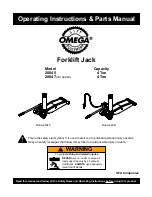
15
MAINTENANCE SCHEDULE
The periodic Preventive Maintenance Schedule given is the suggested minimum requirements and minimum
intervals; accumulated hours or monthly period which ever comes sooner. Periodic maintenance is to be performed
on a daily, weekly, and yearly basis as given in the following paragraphs.
WARNING!!
Occupational Safety and Health Administration (OSHA) and the American National Standards Institute (ANSI)
requires users to inspect lifting equipment at the start of every shift. These and other periodic inspections are the
responsibility of the user.
Failure to perform the daily pre-operational check can result in expensive property damage, lost production time,
serious personal injury, and even death. The safety latch system must be checked and working properly before the
lift is put to use.
Failure to heed this warning can result in death or serious injury, or damage to equipment. If you hear a noise not
associated with normal lift operation, or, if there is any indications of impending lift failure - CEASE OPERATION
IMMEDIATELY! - Inspect, correct and/or replace parts as required.
Daily Pre-Operation Check (8-Hours)
•
1. Check safety lock audibly and visually while in operation
•
2. Check safety latches for free movement and full engagement with rack.
•
3. Check hydraulic connections, and hoses for leakage.
•
4. Check chain connections - bends, cracks-and loose links.
•
5. Check cable connections- bends, cracks-and looseness.
•
6. Check for frayed cables in both raised and lowered position.
•
7. Check snap rings at all rollers and sheaves.
•
8. Check bolts, nuts, and screws and tighten if needed.
•
9. Check wiring & switches for damage.
•
10. Keep base plate free of dirt, grease or any other corrosive substances.
•
11. Check floor for stress cracks near anchor bolts.
•
12. Check swing arm restraints.
Weekly Maintenance (every 40-Hours)
•
1. Check anchor bolts torque to 125 ft/lbs for the
¾
in. anchor bolts. Do not use an impact wrench to tighten anchor
bolts.
•
2. Check floor for stress cracks near anchor bolts.
•
3. Check hydraulic oil level.
•
4. Check and tighten bolts, nuts, and screws.
•
5. Check cylinder pulley assembly for free movement or excessive wear on cylinder yoke or pulley pin.
•
6. Check cable pulley for free movement and excessive wear.
Yearly Maintenance
•
Lubricate chains


































